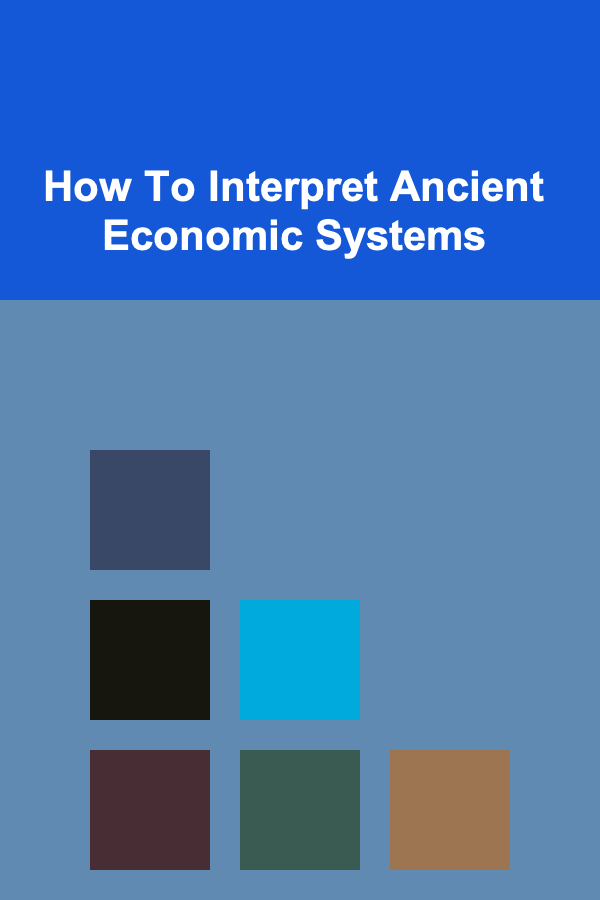
How To Interpret Ancient Economic Systems
ebook include PDF & Audio bundle (Micro Guide)
$12.99$7.99
Limited Time Offer! Order within the next:

The study of ancient economic systems offers an intriguing window into the ways early societies organized, produced, and exchanged goods. These systems, which span across millennia and diverse cultures, reveal the foundations upon which modern economies were built. Understanding how ancient civilizations managed their economies is essential not only for historians and economists but also for anyone interested in the evolution of human society.
In this article, we will explore how to interpret ancient economic systems, focusing on key components such as agriculture, trade, labor, monetary systems, and governance. We will also examine the ways in which archaeology, anthropology, and textual evidence contribute to our understanding of these complex systems. By analyzing ancient economic structures, we can draw comparisons with modern economic models, gaining insights into the continuity and transformation of economic practices over time.
The Role of Agriculture in Ancient Economies
Agriculture formed the backbone of most ancient economies. Early civilizations relied heavily on farming, not just for sustenance but also for the development of social hierarchies, trade, and urbanization. The agricultural revolution, which began around 10,000 BCE, marked a significant shift from nomadic hunter-gatherer societies to settled, agrarian ones. This transition allowed for surplus production, which in turn led to the growth of cities and complex economies.
The Evolution of Farming Techniques
In ancient Egypt, Mesopotamia, China, and the Americas, agriculture was the foundation of the economy. Early farmers utilized rudimentary tools such as hoes, plows, and irrigation systems to cultivate crops. The development of irrigation systems, for example, in Mesopotamia, allowed for the cultivation of crops in arid regions, creating agricultural surplus that supported large urban populations.
In Egypt, the Nile River's annual flooding provided fertile soil for crops such as wheat and barley. This seasonal flooding not only dictated the planting and harvesting cycles but also influenced the rhythms of the ancient Egyptian economy. The surplus generated from farming allowed for the development of specialized crafts, trade, and monumental architecture.
Agrarian Societies and Social Structure
The rise of agriculture had profound implications for social structures. The ability to produce surplus food enabled the growth of specialized labor. In ancient societies, the division of labor became more complex, with people focusing on tasks other than farming, such as crafting, building, and trading. This specialization laid the groundwork for economic differentiation and the development of urban centers.
Economic inequality also became more pronounced. In many ancient economies, land ownership was a key source of power. The elite class, often landowners or those in control of agricultural resources, controlled economic and political power. This concentration of wealth among a small group led to the rise of social hierarchies and class systems that persist in various forms to this day.
The Role of Trade and Exchange
Trade was another critical aspect of ancient economies. While agriculture provided the foundation for local economies, trade allowed for the exchange of goods and resources across vast distances. Ancient civilizations traded commodities like grain, textiles, pottery, spices, and precious metals, as well as more specialized items like slaves, luxury goods, and intellectual property.
Long-Distance Trade Networks
The development of long-distance trade networks in the ancient world was one of the most significant economic developments. The Silk Road, for example, was a complex network of trade routes connecting China with the Mediterranean, facilitating the exchange of silk, spices, and other valuable goods. In the Mediterranean, the ancient Greeks and Romans established extensive maritime trade routes that connected Europe, North Africa, and the Near East.
Trade was not limited to goods; it also facilitated the exchange of ideas, technology, and cultural practices. The spread of agriculture, writing systems, and religious beliefs across different civilizations was often facilitated by trade. For example, the Mesopotamian cuneiform script spread throughout the ancient Near East through trade, while the Greek influence on Roman governance and philosophy was transmitted through trade contacts.
The Rise of City-States and Markets
The growth of cities and city-states was closely linked to the expansion of trade. In ancient Greece and Rome, the agora and forum were bustling centers of economic activity, where merchants, artisans, and consumers gathered to exchange goods. These markets were not only commercial hubs but also places for social interaction and political debate. The wealth generated from trade allowed for the construction of monumental buildings, such as temples, marketplaces, and public baths, which served both as symbols of power and as functional aspects of urban life.
In the ancient Near East, cities like Babylon, Nineveh, and Ur were centers of commerce and culture. Their wealth was derived not just from local resources but also from their strategic positions along trade routes. The use of standardized weights and measures facilitated trade and economic transactions, making these cities thriving centers of commerce.
Labor and Production in Ancient Economies
Labor in ancient economies was often divided along lines of gender, class, and skill. While agriculture was the dominant form of labor for most people, specialized occupations such as craftsmen, builders, and traders also played an important role. The organization of labor in ancient societies provides valuable insight into the economic systems of these civilizations.
Slavery and Forced Labor
In many ancient economies, slavery was a fundamental part of the labor force. Slaves were used in agriculture, construction, and domestic labor. In ancient Rome, for example, slaves worked on large estates (latifundia) producing agricultural goods for the elite. Similarly, in ancient Egypt, slaves and forced laborers were employed in the construction of monumental structures like the pyramids. While the scale of slavery varied between civilizations, it was a central component of economic production.
Forced labor was also common in ancient societies, with individuals often being conscripted for public works, such as building infrastructure or military service. The organization of labor through coercion highlights the unequal distribution of power in ancient economies.
Skilled Labor and Artisanal Production
While much of the labor force in ancient economies was engaged in agriculture, specialized labor was also crucial. Skilled artisans and craftsmen produced a wide variety of goods, ranging from pottery and textiles to metalwork and jewelry. In Mesopotamia, skilled artisans were highly valued, and their products were traded both locally and across long distances. The ancient Egyptians were known for their advanced techniques in metalworking and stone carving, which contributed to the grandeur of their monumental architecture.
Artisan labor in ancient societies was often organized through guilds or workshops, where knowledge and skills were passed down from generation to generation. This kind of labor contributed to the creation of goods that were not only functional but also highly valued for their aesthetic and cultural significance.
Monetary Systems and the Role of Currency
As ancient economies became more complex, the need for a standardized system of exchange grew. Early economies relied on barter systems, but as trade expanded, coins and other forms of money were introduced to facilitate transactions.
The First Coins and the Birth of Monetary Economics
The first coins were minted in Lydia (modern-day Turkey) around 600 BCE. These coins, made of electrum (a naturally occurring alloy of gold and silver), became a standard form of money used in trade. The use of coins spread throughout the ancient world, becoming integral to the economies of the Greeks, Romans, and others. Coins allowed for more efficient trade, as they eliminated the need for barter and provided a tangible, portable form of wealth.
The introduction of coinage also gave rise to early forms of banking and credit systems. In ancient Greece, for example, temples functioned as places where people could deposit money and receive loans. These institutions played a key role in facilitating trade and economic activity.
Debt, Taxes, and Government Control
Monetary systems also paved the way for the development of government taxation systems. In ancient civilizations, taxes were often collected in the form of grain, livestock, or other goods. As economies grew more complex, monetary taxation systems became more common. The Roman Empire, for example, had an intricate system of taxation that funded the military and public infrastructure.
Governments also used taxes and debt to exert control over their populations. In some cases, rulers would offer loans to citizens or city-states, which could lead to cycles of debt and dependence. These economic mechanisms were not only a tool for financing government activities but also a means of consolidating political power.
Interpreting Ancient Economic Systems Through Archaeology and Texts
Archaeological evidence, along with ancient texts, is crucial to understanding the economic systems of ancient civilizations. While we may not have complete records of how ancient economies functioned, the material evidence we have provides a rich source of information.
The Role of Archaeology
Archaeological excavations reveal a great deal about ancient economies. The discovery of ancient marketplaces, storage facilities, and workshops provides insight into how goods were produced, traded, and consumed. In ancient cities, archaeologists often uncover tools, pottery, coins, and other artifacts that help reconstruct economic practices.
For example, excavations in Pompeii and Herculaneum, which were buried by the eruption of Mount Vesuvius in 79 CE, have provided detailed evidence of Roman economic life. The remains of shops, markets, and houses have given researchers a glimpse into the daily life of Romans, including their trade practices, labor systems, and consumption patterns.
The Importance of Written Records
Ancient written records, such as those found in Mesopotamia, Egypt, and China, also provide valuable information about economic systems. The cuneiform tablets of ancient Mesopotamia, for instance, contain detailed records of transactions, including trade, debt, and taxation. These texts give us a sense of how goods were exchanged and the role of money in the ancient economy.
Similarly, ancient Egyptian hieroglyphs and Greek inscriptions contain information about trade, taxation, and economic administration. These written records help historians piece together the complex economic systems that existed in the ancient world.
Conclusion
Interpreting ancient economic systems is a complex but rewarding endeavor. By examining the role of agriculture, trade, labor, and currency in ancient economies, we gain a deeper understanding of how early civilizations functioned and how their economic practices shaped the development of the modern world. Archaeological evidence and ancient texts provide essential tools for uncovering the intricacies of these systems, allowing us to appreciate the ingenuity and resourcefulness of ancient societies. Ultimately, the study of ancient economies not only enriches our historical knowledge but also offers valuable lessons for contemporary economic practices.
Reading More From Our Other Websites
- [Tiny Home Living Tip 101] How to Create a Cozy Tiny Home Fireplace That Meets Safety Codes
- [Organization Tip 101] How to Organize Your Cleaning Supplies for Quick Access
- [Home Pet Care 101] How to Introduce New Pets to Your Household Successfully
- [Home Space Saving 101] How to Store Cleaning Supplies Efficiently in a Small Space
- [Home Budget 101] How to Start a Home Budget with a Small Income
- [Organization Tip 101] How to Set Intentions for Each Week Mindfully
- [Scrapbooking Tip 101] How to Choose the Perfect Scrapbooking Paper Pad: A Beginner's Guide
- [Survival Kit 101] Step-by-Step DIY Survival Kit Checklist: How to Customize Your Emergency Supplies
- [Weaving Tip 101] A Guide to Choosing the Perfect Weaving Tools for Your Craft
- [Simple Life Tip 101] Best Budget‑Friendly Meal Planning Strategies for a Streamlined Kitchen

How to Make Sure Your Home Party Is Comfortable for All Guests
Read More
How to Organize Your Car for Quick Errands
Read More
How to Take Advantage of Tax-Advantaged Investment Accounts
Read More
How To Use Stoic Philosophy for Stress Reduction
Read More
How to Photograph Food for Restaurant Menus
Read More
10 Tips for Integrating Mindfulness into Your Self-Care Planner
Read MoreOther Products

How to Make Sure Your Home Party Is Comfortable for All Guests
Read More
How to Organize Your Car for Quick Errands
Read More
How to Take Advantage of Tax-Advantaged Investment Accounts
Read More
How To Use Stoic Philosophy for Stress Reduction
Read More
How to Photograph Food for Restaurant Menus
Read More